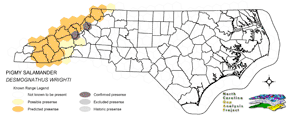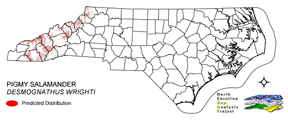
| Taxa: |
| Order: |
| Family: |
| Amphibia |
| Caudata |
| Plethodontidae |
| NatureServe Global Rank: |
| NatureServe State (NC) Rank: |
| G3G4 |
| S3 |
| Federal Status: |
| NC State Status: |
| FSC |
| W5 |


| Land Unit |
| US Fish & Wildlife Service |
| US Forest Service |
| US National Park Service |
| US Department of Defense |
| NC State Parks |
| NC University System |
| NC Wildlife Res. Com. |
| NC Forest Service |
| NC Div. of Coastal Mgmt. |
| Local Governments |
| Non-Governmental Org. |
| Other Public Lands |
| Private Lands |
| GAP Status 1-2 |
| All Protected Lands |
| Statewide |
| Hectares |
| 0.00 |
| 57,596.13 |
| 0.00 |
| 34,383.33 |
| 558.18 |
| 13.86 |
| 798.21 |
| 125.79 |
| 0.00 |
| 2,266.92 |
| 2,466.90 |
| 3.42 |
| 96,004.08 |
| 44,259.00 |
| 98,175.03 |
| 194,216.82 |
| Acres |
| 0.00 |
| 142,323.11 |
| 0.00 |
| 84,963.04 |
| 1,379.29 |
| 34.25 |
| 1,972.42 |
| 462.36 |
| 0.00 |
| 5,601.68 |
| 6,095.84 |
| 8.45 |
| 237,231.20 |
| 109,517.87 |
| 242,747.26 |
| 480,071.65 |
| % of Dist. on |
| Prot. Lands |
| 0.0 % |
| 58.7 % |
| 0.0 % |
| 35.0 % |
| 0.6 % |
| < 0.1 % |
| 0.8 % |
| 0.1 % |
| 0.0 % |
| 2.5 % |
| 2.5 % |
| 0.0 % |
| 0.0 % |
| 45.1 % |
| ----- |
| ----- |
| % of Dist. on |
| All Lands |
| 0.0 % |
| 29.7 % |
| 0.0 % |
| 17.7 % |
| 0.3 % |
| < 0.1 % |
| 0.4 % |
| < 0.1 % |
| 0.0 % |
| 1.2 % |
| 1.3 % |
| < 0.1 % |
| 49.4 % |
| 22.8 % |
| ----- |
| ----- |
|
The range of this species is entirely contained within the southern Appalachian mountain region of Tennessee, North Carolina and Virginia (Martof et al. 1980). Most abundant in spruce-fir forest, but also found (at lesser abundance) in mesophytic cove hardwoods (Huheey and Stupka 1967, Petranka 1998). Adults occupy the forest floor sometimes well away from surface water. Utilize moss, leaf litter, rotten logs, bark of stumps and logs, and rocks for shelter (Martof et al. 1980). NATURE SERVE GLOBAL HABITAT COMMENTS: Chiefly spruce-fir forests, also (in lower abundance) hardwood forests at lower elevations. Hides under moss, leaf litter, logs, bark on stumps, and rocks. Ascends trees to about 2 m in wet or foggy weather. Spends winter in underground seepages. Eggs are laid in underground cavities among rocks of spring seeps. |
| Code | Name | Description | NC Natural Heritage Program Equivalent |
| 521 | Spruce/Fir Forest | High Elevation Frazer-Fir - Red Spruce, Red Spruce and Red-Spruce-Yellow Birch Forests. Tree densities included here include both woodland to forest density. Highly intermixed with Northern Hardwoods, Grassy Balds, and Shrub Balds. | Red Spruce--Fraser Fir Forest, Fraser Fir Forest |
| 526 | Appalachian Cove Forest | Mixed Mesophytic forests of the mountains. Includes tuliptree, basswood, yellow buckeye and surgar maple. This class is mapped to include cove forests dominated or co-dominated by hemlock. | Rich Cove Forest, Acidic Cove Forest |
| 527 | Appalachian Hemlock | Upland hemlock forests of the moutains region. Vary from side slopes to steep slope positions. | Canada Hemlock Forest |
|
Petranka, J. W. 1998. Salamanders of the United States and Canada. Washington DC: Smithsonian Inst. Press.
Huheey, J. E., and A. Stupka. 1967. Amphibians and reptiles of Great Smoky Mountains National Park. Univ. Tennessee Press, Knoxville. ix + 98 pp. Conant, R. 1975. A Field Guide to Reptiles and Amphibians of Eastern and Central North America. Second Edition. Houghton Mifflin Company, Boston, Massachusetts. xvii + 429 pp. Behler, J. L., and F. W. King. 1979. The Audubon Society field guide to North American reptiles and amphibians. Alfred A. Knopf, New York. 719 pp. Martof, B. S., W. M. Palmer, J. R. Bailey, and J. R. Harrison, III. 1980. Amphibians and reptiles of the Carolinas and Virginia. University of North Carolina Press, Chapel Hill, North Carolina. 264 pp. Mitchell, J. C. 1991. Amphibians and reptiles. Pages 411-76 in K. Terwilliger (coordinator). Virginia's Endangered Species:Proceedings of a Symposium. McDonald and Woodward Publishing Company, Blacksburg, Virginia. |
For more information please contact them at:
NC-GAP Analysis Project
Dept. of Zoology, NCSU
Campus Box 7617
Raleigh, NC 27695-7617
(919) 513-2853
www.basic.ncsu.edu/ncgap